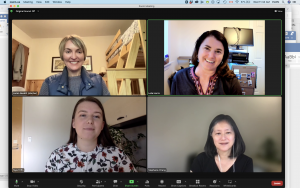
EDGES member Taya Triffo has successfully completed her MA degree from UBC’s Institute for Resources, Environment, and Sustainability. Congrats, Taya! Her master’s thesis was titled “Green infrastructure planning in Vancouver: addressing environmental justice with participatory resident workshops“.
Master’s Thesis Abstract:
Urban rain gardens, wetlands, street trees: these “green infrastructures” (GI) are being used for a variety of urban planning priorities, like climate adaptation and rainwater management. Environmental justice scholars have stressed the need to develop green infrastructure for those who need it most (Anguelovski et al., 2021; Meerow & Newell, 2019). They have also identified “blind spots” in planning processes—from siting, through to public engagement, to maintenance—that may perpetuate uneven development or power imbalances (Brent et al., 2022; Zuniga-Teran et al., 2020). In Vancouver (Canada), modeling and mapping exercises have identified areas that can benefit most from GI development (“equity initiative zones” (City of Vancouver, 2022c); “areas in need of resources” (City of Vancouver, 2022b)). This analysis helpfully indicates who is experiencing environmental vulnerability (e.g., heat, sea level rise), socio-economic vulnerability (e.g., low-income), and lack of urban green amenities (e.g., park access) in the city. As scholars recommend, however, there is a need to understand what these overlapping experiences mean to affected residents, and perhaps more importantly, what residents see as appropriate environmental and climate planning priorities as a result (Hoover et al., 2021). In this project, I facilitated two participatory workshops with residents who live in Vancouver’s eastern neighbourhoods, asking: what are residents’ self-identified GI priorities, challenges, and aspirations? Participants shared how GI projects can be adapted to meet their needs as renters, parents, seniors, immigrants, and low-income individuals. Participants wanted to see GI in the everyday spaces where they spend their time, noting possibilities such as developing green roofs directly on their affordable housing units. Second, participants stressed that improved livability (namely through public transit and affordable housing) can improve their overall experience with GI. Supplementary expert interviews (n=4) and an integrative document review (n=25) revealed other factors that might obscure or limit pathways for equitable development. These factors include opportunistic development patterns, budgetary constraints, and a lack of specific, actionable equity objectives. As the City of Vancouver continues to strive for equitable green infrastructure development, this project synthesizes potential entry points and limitations.